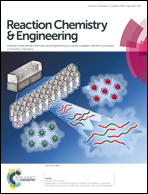Catalytic oxidation of aqueous bioethanol: an efficient upgrade from batch to flow†
Abstract
The heterogeneously catalyzed oxidation of (bio)ethanol to acetic acid is an environmentally friendly alternative to the current industrial Monsanto process. The reaction yields acetic acid from crude bioethanol under mild reaction conditions. The triphasic reaction is technically critical, due to mass and heat transfer limitations and is thus predominantly studied in batch reactor systems. However, in order to advance the industrial implementation of the catalytic route, the operation in flow at the research stage is necessary. It is an efficient, reliable, and safer system for triphasic reactions and allows us to define better performance parameters for a later up-scale of a continuous flow process. Here, we evaluated the aerobic ethanol oxidation in a flow reactor and compared it with a traditional batch system over a gold–titania catalyst under analogous conditions. In both reactors, the reaction mechanism was similar: there was a zero-order dependency in oxygen and a first-order dependency in ethanol. The different reaction orders indicate that oxygen and ethanol interact with different surface sites, possibly ethanol with gold and oxygen with the support. The study showed that the catalytic performance improves in flow by about 30% for conversion and by 10% for acetic acid selectivity. The enhancement is associated mainly with the greater resistance of gold to sintering in the flow reactor. The study underlines the necessity of switching research to flow systems in order to benchmark more efficiently and identify potential catalysts for industrial implementation as well as to enhance our understanding of triphasic reactions.



 Please wait while we load your content...
Please wait while we load your content...